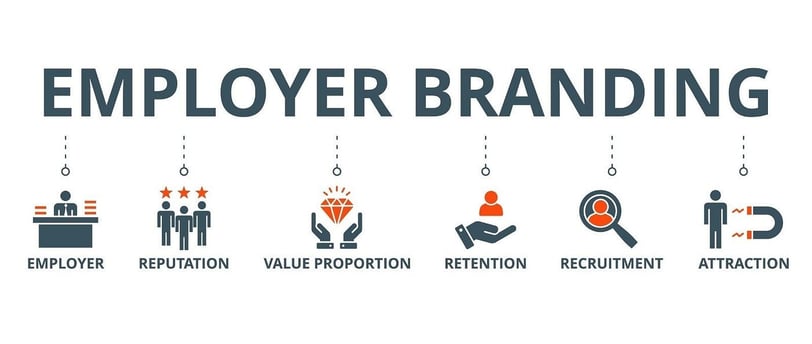How to Build a Strong Employer Brand to Attract Top Talent
3/26/20254 min read


In today's competitive job market, attracting the right talent is not just about posting a job opening and hoping for the best. It's about building a strong employer brand that resonates with the values, mission, and culture that prospective employees are looking for. A powerful employer brand can help you stand out from the competition, boost employee morale, and reduce hiring costs.
So, how can you build an employer brand that attracts top talent? Here’s how:
1. Understand Your Current Employer Brand
Before you can strengthen or build your employer brand, you first need to assess where you stand. Start by asking your current employees how they perceive the company. Conduct surveys, focus groups, or one-on-one interviews to gather feedback. You should also monitor online reviews on platforms like Glassdoor and LinkedIn. These can give you valuable insight into the employee experience from the outside looking in.
2. Highlight Company Culture and Values
Top talent wants to work for companies that align with their personal values. Make sure your company culture is clearly defined, and communicate it effectively both internally and externally. Your values should be reflected in your day-to-day operations, leadership style, and how you treat your employees.
For example, if work-life balance is a core value, demonstrate this by offering flexible work hours, remote options, or generous paid time off. Likewise, if innovation is at the heart of your company, show how you invest in employees' professional growth and creative freedom.
3. Leverage Social Media and Online Presence
Today, candidates often do their research before applying for a job. This means your online presence is more important than ever. Use social media platforms like LinkedIn, Twitter, Instagram, and Facebook to showcase your company’s culture, team events, and achievements.
Content ideas include:
Behind-the-scenes glimpses of daily life at your company.
Employee testimonials or "day in the life" stories.
Celebrating milestones, achievements, and awards.
Sharing company events and social responsibility initiatives.
An active and engaging social media presence can give potential candidates an inside look at your organization before they even apply.
4. Provide Growth and Development Opportunities
Top candidates are always looking for opportunities to grow. This doesn't just mean promotions (though they are important). A strong employer brand focuses on employee development at all levels. Offer training programs, mentorship opportunities, and resources for professional development. A company that invests in its employees’ careers is more likely to attract top talent.
You could also consider offering programs like:
Tuition reimbursement for further education.
Cross-training opportunities within the organization.
Leadership development programs.
Candidates who see a company as a place where they can develop professionally will be more likely to apply and stay long-term.
5. Create an Engaging Candidate Experience
The recruitment process is often the first interaction a potential employee has with your company, and it’s a critical one. An unorganized or impersonal hiring process can deter great candidates from applying, or worse, lead them to withdraw from the process altogether.
To ensure a positive candidate experience, make the hiring process as seamless and respectful as possible:
Communicate frequently with candidates about where they stand in the process.
Provide clear feedback after interviews.
Make your interviews engaging and focused on assessing the candidate’s fit for the role and the company culture.
A positive hiring experience not only helps you hire top talent but also enhances your employer brand through word-of-mouth recommendations.
6. Offer Competitive Compensation and Benefits
Salary is not everything, but it certainly matters. In addition to competitive salaries, offer benefits that appeal to top talent. Comprehensive healthcare, retirement plans, wellness programs, and paid family leave are all attractive perks that can set your company apart.
In today’s workforce, candidates also value non-traditional benefits, such as:
Mental health support.
Student loan assistance.
Flexible work schedules.
Opportunities to volunteer during work hours.
Be sure to understand the benefits your target candidates value most, and make sure your package is competitive for your industry and location.
7. Encourage Employee Advocacy
One of the best ways to build your employer brand is through your current employees. Encourage them to share their experiences on their social media profiles or write about their careers at your company in blog posts. Employee testimonials are powerful tools in showcasing your company’s values and culture from an authentic, personal perspective.
You could also create an employee referral program to encourage your current staff to recommend top talent from their own networks. Employee referrals often lead to faster hires, lower turnover, and better quality candidates.
8. Measure Your Employer Brand’s Success
Building an employer brand is a continuous process. It's essential to regularly assess your progress to ensure your brand remains strong. Use metrics such as employee retention rates, candidate satisfaction, application rates, and social media engagement to track the effectiveness of your employer branding efforts.
Tools like employee surveys, Net Promoter Score (NPS), and candidate feedback can provide data to help refine your strategies.
Conclusion
Building a strong employer brand is not something that happens overnight, but it’s worth the effort. By focusing on a positive, inclusive, and development-oriented culture, you’ll attract top talent that aligns with your company’s values and goals. Remember, a strong employer brand makes your company not just a place to work but a place where employees are excited to contribute and grow.
With the right strategy, your employer brand will not only help you hire better but also foster a more engaged, loyal, and productive workforce.
Candidates
Looking for a job or following up on a job application?
recruitment@camaconsultingllc.com
Admin & office
Get in touch
admin@camaconsultingllc.com
Ph: 985-400-3598
© 2024. All rights reserved.
Clients
Looking to connect with our Business team?
sales@camaconsultingllc.com
Mailing Address: 120 HOLIDAY BLVD COVINGTON, LA 70433
